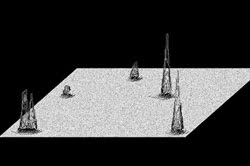Mobile spectrophotometer tests for contaminants.
Jeff Prevatt, S.I. Photonics
Shortly after Sept. 11, an incident arose in which a water reservoir had been tampered with. The severity and seriousness of the act resulted in speculations of terrorist activity.
The reservoir in question was the primary water source for a small community, and any delay in service would have serious consequences. Water samples were obtained for immediate testing for a series of pollutants and biological agents. Although it was unclear what specific parameters to look for, a variety of tests were conducted to identify possible contaminants.
The problem was exacerbated because the analysis could take days to complete and costs could run close to $4000. A similar incident occurred in the fall of 2003 in Willcox, Ariz., where the town’s water supply was offline for more than 24 hours as the result of vandalism.
Arizona researchers designed a method of water testing that obtains instantaneous results and that costs less than previous methods. The chemists, now with S.I. Photonics Inc. of Tucson, Ariz., in conjunction with the University of Arizona and Pima County Wastewater Management, developed a prototype direct current plasma atomic emission spectrophotometer for use in screening a variety of wastes.
Contaminants in solutions
The instrument uses an echelle spectrometer outfitted with a charge-injection-device detector. It is unique in that it can deliver a simultaneous, multielement fingerprint of contaminants present in solutions. The two-dimensional image produced in an echelle is ideally suited for use with devices such as charge-injection-device detectors and CCDs, and has become the preferred optical design for most emission spectrometers. What sets this instrument apart from existing emission spectrometers is its ability to handle both complex and drinking water matrices effortlessly as a result of the direct current plasma source.

Figure 1. This fingerprint shows the elements present in a sample after image subtraction, indicating the presence of possible pollutants.
Direct current plasma spectrometers were popular in the early 1980s, prior to the introduction of inductively coupled plasmas, which outperformed their predecessors in stability and sensitivity. However, because of size, and power and argon consumption requirements, the inductively coupled devices have had very limited success in mobile laboratories.
Using the improved optical designs introduced throughout the 1990s, the new prototype exhibits the latest in photonics technology, including array detection and enhanced ultraviolet coverage. The size has been significantly reduced through the use of fiber optics and Peltier cooling of the detector to fit within a standard minivan.
The most difficult aspect of analytical testing in a scenario such as this is deciding which tests to perform. The echelle spectrometer helps in this area because, without having to quantitatively identify any single parameter, a qualitative multielement fingerprint is obtained. To determine if a pollutant is present, two analyses are performed.
First, a sample of the source water is analyzed and the image is saved digitally. The image of a second analyzed sample is subtracted digitally from the original image. Ideally, the two spectra should be identical and cancel each other out, indicating no contaminants. Any analyte present after image subtraction would positively identify the contaminant in the reservoir.
Because this is an atomic technique, it can identify only base atomic elements. For example, it could not demonstrate the presence of a particular pesticide in the water, but it could positively identify a higher concentration of halogens and carbon.
This information proved invaluable as it successfully screened the samples and permitted testing to focus on either organic or inorganic constituents for analysis. Given the lengthy turnaround for traditional analysis, this key bit of information could reduce response times and analytical costs by focusing analysis on the priority constituent.
S.I. Photonics is making the instrument footprint even smaller for mobile operation and will retrofit the camera with a more versatile and larger-format CCD camera. When not using the mobile instrument for security-related analysis, the wastewater department will employ it for point source monitoring of the collection system to identify sources of contaminants discharged to the sanitary sewer.
Meet the author
Jeff Prevatt is superintendent of technical services for Pima County Wastewater Management and co-owner of S.I. Photonics Inc. of Tucson, Ariz.; e-mail: [email protected].